| Adventure |
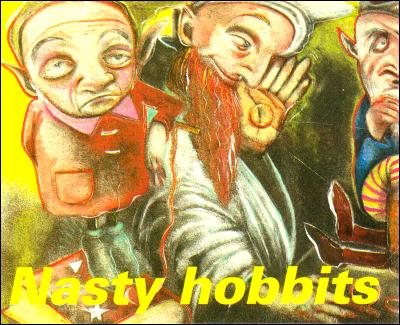
Richard Price sets out on the road to Rivendull while Tolkien turns in his grave
NOT LONG AGO, after a long day at the keyboard, I settled down in front of the TV for a few hours of mindstretching intellectual activity - namely Hawk the Slayer, a film which would make Mary Poppins seem like high art.
At the beginning was a short voiceover which summed up the plots of about 75 percent of all adventure programs: "This is a story of heroic deeds and the bitter struggle for the triumph of good over evil and of a wondrous sword wielded by a mighty hero when the legions of darkness stalked the land."
All but one of this month's software fall into this category. Games designers seem to think that this sort of plot is all that most players need. I doubt it and once again make a plea for real storylines and humour. Grumble, grumble ...
Never mind though, Delta 4 Software has taken the archetype of all those solemn hero tales and turned out a classic parody.
|
Bored of the Rings is a direct and cheerful spoof of Tolkien's trilogy, only the names and aims have been changed to protect the innocent - and to avoid hassles with the copyright.
The game is in three parts and has been written with the Quill. There are also graphic scenes produced by Gilsoft's new Illustrator package. Delta 4 has plumbed in a fairly pleasing medieval-style typeface and the general presentation is clear and easy on the eye. You get from one part to the next by way of a password given at the end of each section.

First, the plot. Naturally it is very similar to the original but the characters and detail are, ahem, somewhat different. Fordo the Boggit lives in the Shire with his uncle Bimbo. On the principle of W C Fields' dictum 'never give a sucker an even break' he gets landed with the job of returning the Great Ring to Mount Gloom in the Land of Dormor.
So begins the great quest. Fordo and his cowardly chums, Spam, Pimply and Murky set off for Whee through the forest. On their way they encounter Tim Bumbadil, the ageing acid-crazed hippy and his flower-child girlfriend Hashberry.
From Whee they head towards Rivendull where the full company teams up. There's Legoland the Elf, Giblet the Dwarf and Aragont, who continually recites his ancestors' names at any conceivable opportunity.
Part one ends at the gates of the Morona Cave Tourist Complex and is fairly simple to solve, acting as more of a scene setter than anything. The second and third sections are tougher but retain the same irreverence towards the great epic.
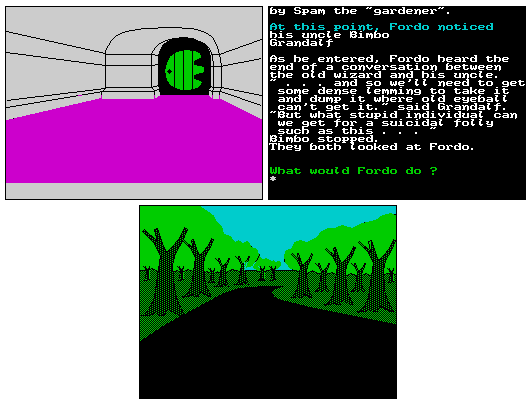
The humour can be fairly schoolboyish at times and there are a couple of occasions when it is both distasteful and unnecessarily unpleasant. On the whole though the game is great fun and well-produced too.
For your £5.95 you will get two cassettes and a daft little booklet with a map of the trek. There's also a microdrive version at £8.95. Fergus McNeill, the author, has told me that the game has been accepted for distribution so you should have little trouble getting it. If not, write to Delta 4, Hampshire.
|
This month is not the Delta 4 Benefit Month and it is pure coincidence that another of its games has turned up in my in-tray.
Return of the Joystick is the sequel to The Quest for the Holy Joystick. I have never seen the first game but I presume the aim is the same. Like Bored this adventure is written with the Quill and Illustrator and features the same quirky sense of humour.
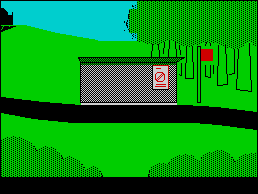
The game begins outside Alexandra Palace where one of the many ZX Microfairs is about to open. You are a typical computer punter on the lookout for cheap games and equipment. Little do you know that your simple needs will lead you into the search for the Holy Joystick which is secreted somewhere within the several reality layers of the game.
From the bus stop at Ally Pally you can wander around London and its suburbs. Various well known computing firms can be visited and, in the offices of a nameless publishing company, you will encounter T*ny Br*dge and other agents of darkness.
Large numbers of computer games can also be found there - such as Chublock and Sabre Wilf - and you can enter those games to find vital objects.
There's an element of satire and large numbers of gratuitous tricks - I stepped off the path at Ally Pally only to be devoured by a Bengal tiger and told: 'Gosh, that was unfair wasn't it? Another feeble attempt?'
Reality shifts between the ordinary world and the strange environments of the games. Occasionally you will step into a new location only to find yourself in the USSR or the mystic territory of Delta Tower.
Every entry counts as a minute in the game world and some things will only happen at particular times - if you're in the wrong place that's tough.
Starting time is 9am and you must finish by 10pm. The game gives very little help and it is easy to waste time.
Return of the Joystick is not as compulsive as Bored but it is equally well put together and does have the virtue of not being an orc-basher game. Some of the humour relies upon in-jokes and you may find that some of the characters are unknown to you - the world of computing companies and magazines may seem big to those in it but to outsiders it may not have the same appeal.
|
There is another double feature this month - this time from Games Workshop.
Runestone is, as far as I know, the only game to date which combines the kind of graphic countryside pioneered in Lords of Midnight with a regular text adventure interpreter.
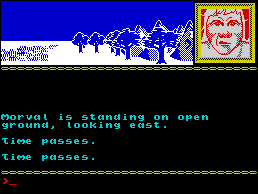
The legions of darkness in this game are commanded by Kordomir the Dark One. To overcome this evil you must find the Runestone but you will have to search the length and breadth of the Northern Wastes to get help from the Mages of Belorn and the secrets of Saromunder. Orcs are everywhere but there are also allies along the way.
You control three characters in turn, each can be sent on their own journeys among the mountains, lakes and meadowlands of Belorn. There are towers, huts, pavilions and caves which can be entered and dragonships for the lake crossings. Other characters live their own lives while you dither over where to go next.
You needn't go all out to crush the nasty Kordomir if you don't feel like it - there are the treasures of Belorn to be found, the bitter joy of battle against the orcs or else you can simply wander around and take in the sights - my favourite, I have to confess. With about 2000 locations and four views to each that's quite a lot of looking.
The graphics are quite like those in Midnight and you move in the direction which takes your fancy. The features advance and recede as you move. The location picture takes up the top half of the screen and the text buffer scrolls up beneath it.
Commands can be strung together with commas and many can be abbreviated, which means you can move through the country very fast if necessary. Up to 63 characters can be entered at any one time so you can type your instructions in with some fluency. The text interpreter only seems to understand the first three letters of each word - this can result in confusion at times.
The three heroes are Morval the Warrior, Eliador the Elf and Greymarel the Wizard. Other folk are generally individuals and I found no armies in the part of Belnor I explored. The game is more traditional adventure than strategy - no bad thing in my book.
You cannot take control of the subsidiary characters and I found them tough to converse with - that is no criticism as interactive characters are a bonus, even in text-only games.
Runestone is an intriguing combination of ideas and formats. The orcs are particularly unpleasant and the combat routines fast and furious. The heroes each have their own cross to bear and their own skills. And watch out for Skrimnal who will rip you off something rotten!
|
The second Games Workshop release is Key of Hope, the successor to Tower of Despair and a two part adventure with some graphics.
Tower featured a cover picture of a strapping weight lifter. Key of Hope sports a dramatic, nay pneumatic, warrior-maiden surrounded by fierce beasts and icy pinnacles ... phew.
This program too is written on the Quill and has a difficult gothic typeface. The plot continues the tale of Aelandor in Tower.
Castle Argent has been reduced to ruin and the ever-evil Malnor threatens to take over the world. Find the pieces of the key and then destroy Malnor - thus saving the world for the White Goddess of Truth.
All this is better than going to the office though a bit more strenuous. There are 400 locations and an assortment of magical artifacts and horrors.
The graphics on the review copy were very simple although a call to the Workshop gave me reassurance that these were not the final versions. Neither was the Examine function very productive, except with specific objects, and it could have more variation in its response.
If you enjoyed Tower of Despair then you will no doubt relish the sequel.
|
Still in the worlds of wizardry we come finally to Ashkeron.
The wizard has purloined poor Princess Zeraphina's dowry of five great treasures. Without them her marriage will be ill-starred and will bring ruin to the bucolic paradise of Ashkeron. You are Stephen the Blacksmith and have vowed to enter the sorcerer's lair to recover the sparklers.
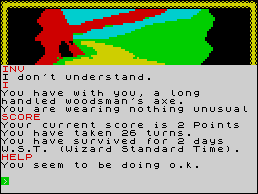
You might be forgiven for thinking this was an Avalon style graphics game - 'walk-thru graphics' on the cover could suggest this. In fact the game is a text adventure with graphics which blend into the next location picture when you move. That happens with a machine-gun roaring which adds nothing to the game.
Text input is standard verb-noun and you can choose between a game where the objects always begin in the same place or a randomised version. The game is in real time so events will progress whether you do or not.
The castle is quite large and complex though often you can do nothing with the rooms - in the clock tower you cannot examine either the tower or the clock. Other characters can be spoken to and the castle staff can occasionally be helpful. The Examine function can be odd - I picked up a candle, tried to examine it and was told it was not there!
The trouble with games which expect you to find treasure is that there is no other incentive to carry on, especially if careful exploration only results in information about things the programmers consider important.
This is not my type of game. It is not enormous - only 125 locations - and it doesn't have the detail which provides a compelling atmosphere. Nevertheless, it is well-made and attractively presented. The prospect of a £25 prize each month for the highest score may induce you into Ashkeron. Not me - I'm going to get back to Fag End and Boggiton.
|